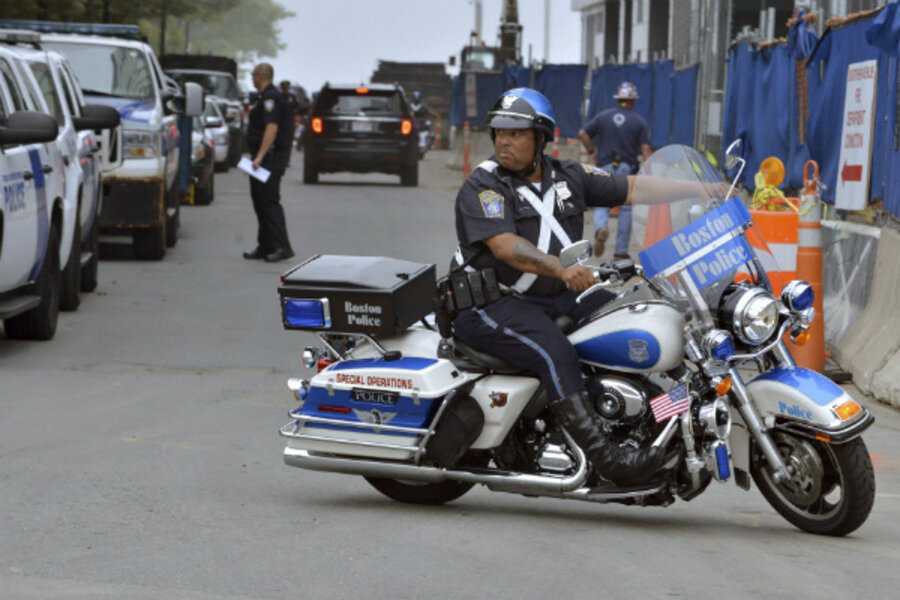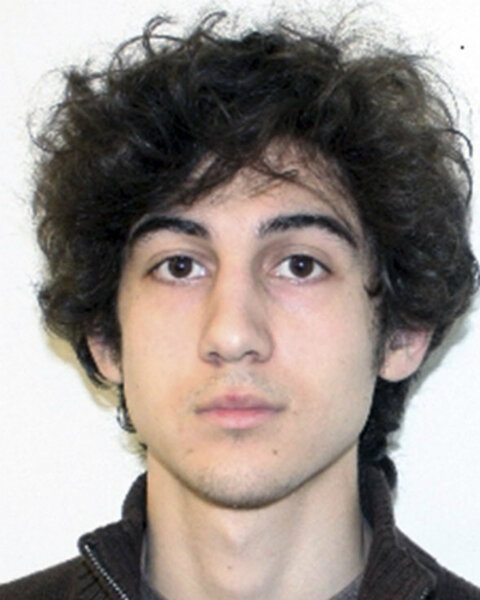Boston Marathon bombing: On first day in court, suspect to face public
Loading...
| BOSTON
For the first time since he was taken into custody in the days following the Boston Marathon bombing, Dzhokhar Tsarnaev will face members of the public Wednesday in US District Court in Boston, where he is to be arraigned on terrorism charges, some of which authorize the death penalty.
During the hearing, Mr. Tsarnaev, an ethnic Chechen, will be formally charged in front of a federal judge with 30 federal criminal counts, including use of a weapon of mass destruction and conspiracy resulting in the deaths of four people and injury of 260 others in the crowd at the Boston Marathon.
Among the charges he faces are responsibility for the deaths of Krystle Campbell, Lingzi Lu, and eight-year-old Martin Richard by setting off, and conspiring to set off, improvised pressure-cooker bombs on April 15. He is also expected to be charged with killing MIT police officer Sean Collier in his cruiser days later.
Seventeen of the charges authorize a penalty of up to life in prison or the death penalty, while the remaining charges carry a maximum penalty of life in prison or a fixed term, according to the US Attorney’s office.
‘‘We will do everything that we can to pursue justice,” Carmen Ortiz, the US attorney in Boston, said after the indictment was first unveiled in late June.
The hearing could be a straight-forward one limited to a simple reading of the charges against Tsarnaev while he and his attorneys listen – and family members of some of those killed watch from the gallery. But it could also include a series of quick legal moves by both prosecutors and defense teams, including steps required to seek the death penalty – and counter moves by the defense.
Over the past 4-1/2 years, the Justice Department has sought executions in several cases, but such cases can be protracted and none has yet seen any of those convicted placed on death row, the Associated Press reports.
Seeking the death penalty in Massachusetts, which has outlawed its use for state crimes, is still possible because Tsarnaev is facing federal charges. Even so, if the death penalty is sought, a jury must be unanimous in deciding on it in a separate sentencing trial following a conviction. Tsarnaev’s defenders reportedly already include an anti-death penalty expert, Judy Clarke, who has successfully deflected the death penalty in other high-profile cases.
Still, it remains unlikely that the federal government will formally announce it is seeking the death penalty at this early phase, since it can be announced by federal prosecutors later, before the trial begins, death penalty experts say.
“This is most likely to be only a reading of the indictment against Tsarnaev, but the charges will be noted as ones that can carry the death penalty – the counts all line up that way,” says Richard Dieter, executive director of the Death Penalty Information Center, a nonprofit group based in Washington that collects data on the death penalty cases but does not take a position for or against it.
“Even though it is unlikely the prosecution will announce it is seeking the death penalty, everyone in the courtroom will know, from the judge to the defense team, that these are death penalty kind of charges,” he says. “You may hear nothing from the defense team. But they also could immediately seek additional representation.”
If it believes the death penalty will be sought, the defense likely will immediately ask the judge for additions to its legal team, Mr. Dieter says. Those lawyers would immediately begin researching Tsarnaev’s childhood and any extenuating circumstances that might have caused him to commit such crimes – and potentially sway a jury much later, during the sentencing phase.
Specifically, the indictment listing the 30 charges alleges that on April 15, 2013, during the 117th running of the Boston Marathon, Tsarnaev and his brother Tamerlan placed improvised bombs among the crowds cheering runners toward the Marathon finish line. After placing the bombs, Tsarnaev and his brother detonated the bombs seconds apart, killing three people, maiming and injuring many more, and forcing a premature end to the Marathon, the indictment says.
Hours after the FBI released photographs of the pair on April 18, 2013, Tsarnaev and his brother, armed with five more improvised bombs, a semiautomatic pistol, ammunition, a machete, and a hunting knife, drove their car to the Massachusetts Institute of Technology.
There, the pair are alleged to have shot and killed MIT Police Officer Sean Collier and tried to steal his gun. Shortly after, Dzhokhar Tsarnaev and his brother carjacked a driver, forcing him to drive to a gas station and robbing him of $800. After the driver escaped, the brothers are said to have driven the carjacked vehicle to Watertown, where local police officers tried to apprehend them. The brothers fired at and threw four additional bombs at those officers, the indictment alleges. Leaping into the carjacked vehicle, Dzhokhar is said to have driven it at the officers, but ran over his brother, severely injuring him.
After that escape, Tsarnaev is alleged to have hidden in a dry-docked boat in a Watertown backyard until his arrest the following night. While inside, the indictment alleges that he wrote a message on the inside wall of the boat.
“The US government is killing our innocent civilians,” read the message, according to the indictment. “I can’t stand to see such evil go unpunished. We Muslims are one body, you hurt one you hurt us all. Now I don't like killing innocent people, it is forbidden in Islam, but due to said [unintelligible] it is allowed." Also: “Stop killing our innocent people and we will stop.”









